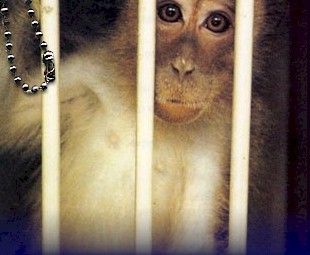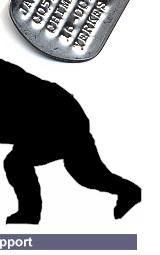






|
||||||||||||||||||||||||||||||||||||||||||||||||||||||||||||||||||||||||||||||||||||||||||||||||||||||||||||||||||||||||||||||||||||||||||||||||||||||||||||||||||||||||||||||||||||||||||||||||||||||||||||||||||||||||||||||||||||||||||||||||||||||
| UCD #25205 25205
is a crab-eating macaque; a Macaca fascicularis in the jargon
of taxonomy. A cynomolgus monkey, in the jargon of biomedical research
laboratories.
In any event, the entry of January 27, 1993, is the only one referring to electroejaculation in the records reviewed for 25205. The electroejaculation came almost precisely on 25205’s third anniversary at CRPRC. On February 9, an entry says that 25205 has been reported for dehydration again, but that he may just naturally appear to be dehydrated due to his dark eyes and skin. On February 21, he is seen again for a wound to his right hand. On March 5, he is reported to have loose stool again. In almost every entry through June 19, 25205 is reported to have “loose stool,” “stool partially liquid,” or “liquid stool.” On the 19th, he is reported to be vomiting as well. July 2: “depression. Not confirmed.” July 29: “Variable stool and vomit confirmed.” This continues throughout the rest of the year. And on February 2, 1994, he is reported to be depressed. On March 30 1994, 25205 is tattooed again. On April 4, the entry notes that a tech had reported that 25205 had lacerations on his left arm. The person making the entry says that these wounds seem old and superficial, and that there was not any swelling. On May 11, he is seen again for another wound to his left hand. On September 11, this entry appears: “.6cc Ket. Abrasion to (L) forearm. Animal may have gnawed himself. Wound was very superficial & old, was already scabbing over. Shaved area cleaned wound w/DNS & applied granulex. Monitor healing. Should heal fine by itself.” On September 12, it is noted that he is vomiting. On November 2, he is again treated for wounds to his left arm. It is noted that he has a history of wounding in this area. They note that he still has his canine teeth and that this “may lead to problems.” They request that his canine teeth be cut down and suggest that research services be notified of 25205’s “possible stereotypic behavior.” Stereotypic behavior is behavior believed to be outside the norm for caged animals. It is a problem in the primate labs of epidemic proportion. One study at the New England Regional Primate Research Center reported that ten percent of the monkeys at that institution (a part of Harvard University) injured themselves severely enough as to require veterinary intervention. [M. A. Novak, J. H. Kinsey, M. J. Jorgensen, T. J. Hazen.1998. Effects of puzzle feeders on pathological behavior in individually housed rhesus monkeys. American Journal of Primatology ;46(3):213-27.] Stereotypic behaviors include self-biting and other self-mutilations, bizarre movements such as endless twirling and jumping and the repetitive pacing common in many caged animals. In the Oregon undercover video a very young isolated monkey is curled into a ball sucking his penis. Interestingly, researchers variously claim that the causes of such behavior are largely unknown; while others claim that most such behaviors are eliminated when monkeys are able to touch one another. These behaviors are essentially unknown among wild or group-housed primates. Only the primate research laboratories are unable to make the logical inference: primates caged alone go insane. On November 26, 1994, 25205 is seen for another wound. This time a small wound on the tip of the second finger of his right hand. On December 7, he is reported to be vomiting again. December 29: “Reported for self-trauma to (L) forearm. .7cc ket. Traumatic lacerations to both forearms. (L) forearm has small 1&Mac218;2 cm full-thickness skin laceration – not involving underlying muscle. Cleaned and sutured…surrounding tissue has multiple bruises and contusions. (R) forearm has ~ 1cm full-thickness skin laceration with minor trauma to underlying muscle. Cleaned and sutured….monitor for future evidence of self-trauma.” The following day it is noted that the sutures have been pulled out and the bandages are gone. But, the wounds seem to be “healing well.” [An overnight miracle?] On January 2, it is noted that both arms seem to still be healing but that right arm’s suture site is swollen and appears moist. On January 30, 1995, 25205’s five year anniversary at CRPRC, he is reported to have mild abrasions on his right hand. On February 7, his stool is again noted to be of varied consistency. On April 6, they performed a “pulpotomy” on his upper canine teeth and blunted his lower canines. On April 17, he was reported again for “self-trauma” to his left arm. He had been biting his arm near his wrist. Entries through April 24 note that the wound is healing well. On May 21, he is treated again for a new wound to his left forearm. On the following day, 25205 is anesthetized for a tuberculosis test. The wound on his arm is treated. A sore is discovered under the collar he has apparently had on for over two years. The entry notes: “Had sore on neck from too tight collar. Collar removed.” Treatment continues for the wound on his arm. On May 26, it is noted that the wound has fresh blood on it and that he seems to have been biting himself again. Throughout this time, the wound was being treated with the common wound dressing, Granulex. It is suggested that the Granulex may be irritating the wound and maybe that’s why he continues to chew on himself. They switch to aloe vera. 25205 licks off the aloe vera. The wound continues to be treated with aloe vera spray. On June 5, it is noted that the wound has nearly healed and that the skin has grown in well. On June 22, he is reported to have reopened an old wound on the tip of a finger of his right hand. On October 26, he is reported to be vomiting again. On November 14, 25205 has diarrhea again. And again on April 19, 1996. And on April 22. And then, on April 23, his stool is reported to me scant, very bloody and with mucus. On November 24, it is reported that no parasites can be found. On June 13, he has loose stool again. This continues through the 21st when he is again reported to be vomiting. Every entry through August 16 comments on his loose stool. Many tests are run and nothing is diagnosed. On September 28, he is again seen for self-inflicted trauma: “Abrasions, bruising, and inflammation of (L) proximal forearm – self-inflicted.” The wound is treated. October 3, 1996: “Noted recent trauma to both arms most noticeable on the (L) forearm. Continue to monitor. If new trauma is observed reassess. Also notify enrichment coordinator.” October 8. He is reported to have liquid stool. Minor trauma to his left forearm is again noted. On October 9, he is vomiting again. On October 14, an entry says that his wounds are healing well, and that his diarrhea is self-limiting. He is discharged from medical care. November 2, and he is again vomiting. On January 22, he again is reported to have liquid stool. It is noted on January 28 that his diarrhea is persistent. More lab tests come back negative. On January 30, 1997, after seven years at CRPRC, the entry reads, “Maintaining well.” The diarrhea persists. On February 7, 1997 someone enters the comment, “Diarrhea self-limiting.” On June 16, 25205 is again seen and treated for wounds to both forearms. They are described as superficial contusions and abrasions. June 24: “Rept. for arm trauma. The trauma was observed on the (R) arm and was superficial & did not appear inflamed or infected animal has [history] of self-trauma to arms. Notify enrichment coordinator. Monitor closely. Assess for anti-anxiety [medication].” On July 10, 25205’s teeth are again “cut down” as a cure for his self-biting. On July 23, he again is reported for loose stool and vomiting. The loose stool persists, more negative lab tests, more monitoring. October 11: “reported arm trauma confirmed. 1 small puncture wound to (L) medial proximal forearm. No redness, bleeding or swelling. Observed grooming arm. Possible self-trauma to arm. Monitor.” October 15. Liquid stool confirmed. More diarrhea throughout the rest of the month. On October 30, they start treating 25205 with Flagyl (Metronidazole), a common medicine for various gastric parasites. On November 2, he is vomiting again. On November 4, there is no sign of diarrhea and on November 9, the notation is made: “Resolved diarrhea.” November 17. Reported for liquid stool. On November 24, 25205 is reported to have a poor appetite. On January 7, the liquid stool is continuing and he is vomiting again. A note is made that should the liquid stool persist, that some should be collected and sent to the lab, and that he should be monitored for more vomiting, and that, if his condition remains the same, a referral should be made to the vet. The diarrhea continues. On January 20, 1998, the notation is made that the diarrhea is “nonpathogenic” and that the he should continue to be monitored. On January 22, someone suggests that they try anti-inflammatory steroids if the ‘condition persists.” The liquid stool persists intermittently throughout the ensuing months. 25205 continues to vomit occasionally. On June 15, 1998, and again on October 19, he is subjected to some experimental procedure – probably an injection of some kind. The details are blacked out. CRPRC claims this is due to “verbal and physical harassment, including death threats, which have been made against these individuals [involved in the research].” On December 12, he is reported to still be experiencing loose stools and to have a poor appetite. On March 15, he is reported with neck trauma. A scab on his right hand is noted. It is all considered as minor and no treatment is pursued. On August 8, 1999, a note is made that he has loose stool. A comment is included that suggests this is because he received raisins as an enrichment the day before. On January 14, 2000, 25205 is again seen for trauma to his arms. It is noted that this is presumed to be self-inflicted. January 21: “Reported fore arm trauma. Confirmed. Gave .5 cc Ketamine to evaluate wound. (L) fore arm have numerous superficial bite wounds as well as to (L) bicep.” (sic) The wounds were treated. It was noted that the wounds were self-inflicted. The observer notes that 25205 is a “self-biter” and suggests that they should try to “make animal busy through enrichment.” On February 8, 9 and 10, he is reported with more diarrhea. On February 25, there is more trauma to his left arm. More diarrhea. On May 11, he is vomiting again. Between May 11, and August 12, 2000, the last record available for 25205, 26 daily entries are recorded. All of them deal with the fact that he has diarrhea. Chronic diarrhea is epidemic in the primate labs. 25205’s life has been one of chronic illness. The stress of a caged existence has caused him to bite himself and chew on his own arms repeatedly. His capture, incarceration, and misery have served no purpose to humans other than providing jobs to cage cleaners and veterinarians. Those who claim that animals in laboratories are well-treated, respected, and irreplaceable to modern medical research are ignorant of the facts concerning the actual lives of the animals about whom they comment. Literally tens-of-thousands of monkeys such as 25205 are suffering through similar lives today in taxpayer supported laboratories across the country precisely because of the deafening silence from the public regarding their plight. If this silence is an artifact of the public’s ignorance, hopefully 25205’s miserable life and story might serve to educate. 25205, our thoughts are with you. |
||
Home Page | Our Mission | News |